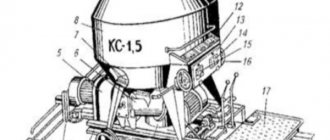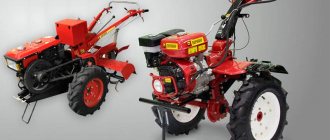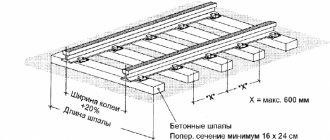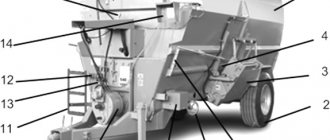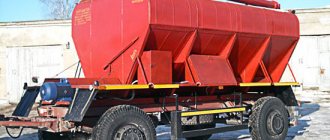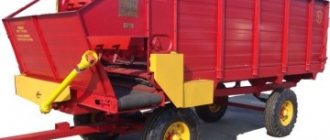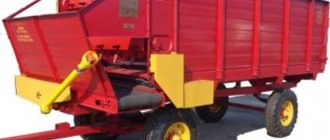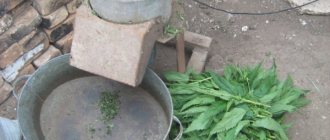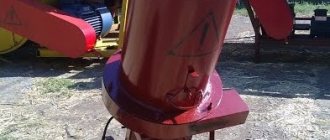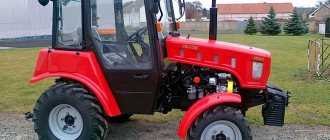Varieties
The main purpose of feed dispensers is the mechanized distribution of feed mixtures for animals and birds. Such units significantly simplify the process of caring for animals and reduce the time spent on feeding.
According to design features, all feed dispensers can be divided into two categories: stationary and mobile.
Stationary
Such models are installed indoors and are suitable for poultry and livestock farms.
The main element of the equipment is the conveyor, which distributes dry food to the feeders, strictly dosing the diet.
Belt, scraper or chain conveyors are used for production; an electric motor is usually used for the drive mechanism.
Mobile
These units distribute feed from the bunker to the feeders, moving indoors. The feed dispenser is driven by a tractor, however, self-propelled modifications are also available.
Note that mobile feed dispensers are usually designed for dispensing dry food, while there are models that work with semi-liquid mixtures. Units of this type are mainly used on pig farms.
The most effective equipment for cattle farms is a self-propelled unit, with an electric drive and a control panel. Please note that such dispensers are installed only in large areas.
When choosing equipment, you must first take into account the size of the internal premises. On small farms with small livestock, it is often impossible to use mobile units.
Therefore, for rational use of internal space, it is worth giving preference to stationary models.
Popular models
Feed dispensers are widely used on farms all over the world. There is an opinion that the best equipment is produced by Western companies, so the price of such models is quite high.
This is not entirely true. Feed dispensers developed by domestic enterprises also show good performance and ease of use.
At the same time, the cost of the units is significantly lower than their Western counterparts. Let's look at the most popular modifications of Russian-made feed dispensers.
KTU-10
This model is produced, which is located in the Moscow region. The product belongs to the category of trailed equipment and is optimally suited for working with Belarus tractors.
The load capacity of the feed dispenser is 4 tons, the internal volume of the bunker is 10 m3. The design is a metal body mounted on a wheeled chassis. The chassis is sprung, the front wheels are swivel and steerable.
The rear chassis is driven and equipped with a hydraulic brake system. The brakes are controlled by the operator from the tractor cab. Please note that depending on the modification, feed can be distributed on one or both sides.
If the trailer has a self-unloading function, then an additional conveyor is installed that unloads the feed mass through the rear side.
Please note that the minimum turning radius of the KTU-10 is 6.5 meters, so the equipment is not suitable for farms with limited internal space.
The production of this model is established in Novosibirsk; this feed mixer has been produced since 2000, designed for grinding roughage with subsequent distribution.
Please note that the plant mass is not kneaded or subjected to heat treatment during the grinding process, and therefore retains all nutrients.
The technical parameters of the feed dispenser are as follows.
| Width | 2.4 m. |
| Height | 2.5-2.7 m. |
| Structural weight (without loading) | 3.9 t. |
| Ground clearance | 30 cm. |
| Capacity | 8.9-10 m3. |
| Feed distribution options | Conveyor belt or unloading window. |
Please note that the equipment is available in several modifications. At the request of the customer, the equipment can be equipped with an electronic dispenser, which stores in memory up to 19 used components and 9 recipes for feed mixtures.
Feed dispenser ISRK-12
This model was developed and put into mass production by Minsk. The equipment is suitable for mixing and dispensing feed mixtures, maintaining dosage accuracy and remembering components (50 recipes, up to 30 ingredients).
The lifting capacity of the equipment is 4 tons, the capacity of the bunker is 12 m3. Please note that the ISRK-12 has increased ground clearance: 420 millimeters, which has a positive effect on the maneuverability and maneuverability of the equipment.
The main advantage of the unit is considered to be independent hydraulics, which ensures uninterrupted operation in sub-zero temperatures. Tractors of 1.4 traction class are usually used as a tractor. The second name of the model is the “Host” feed dispenser.
Please note that the models shown are basic in their model range. Subsequent modifications differ in performance indicators and bunker capacity.
1.3. Construction of mobile feed dispensers
The KTU-10A distributor (Fig. 1, a) is a biaxial trailer with a metal hopper 1, at the bottom of which there is a longitudinal chain-slat conveyor 3, and in the front part there is a block of beaters 2 and a transverse belt conveyor 4. The working parts of the feed dispenser are driven in movement from the tractor power take-off shaft.
Feed is loaded into the bunker by a loader. When the distributor moves along the feeders, the longitudinal conveyor delivers the feed to the beaters. The latter reload it in doses onto a transverse conveyor, with the help of which the feed product is sent to the feeders.
The feed dispenser KTU - 10 A is aggregated with tractors of traction classes 1.4 and 0.9. Thanks to the spring chassis, its movement is possible at speeds of up to 30 km/h. For passage inside the livestock building, a feed passage 2.2 m wide is sufficient.
The body of the feed dispenser is equipped with extension sides, which increases its capacity to 15 m 3 .
Feed dispensers mixers - assistants in cattle breeding
Currently, almost all large livestock farms use various machines and mechanisms. With their help, feed is delivered to the farm, finished products are transported, heat and water are supplied for preparing feed, and many other necessary actions are carried out.
There are many types of livestock farms with different technologies designed for breeding and keeping cattle. But the goal of every farmer is to obtain maximum profit from an individual head of cattle. The high profitability of dairy production depends on whether the farmer has feed dispensers for cattle farms.
Feeding in dairy farming must be rational, because it increases the productivity of the herd. Modern agricultural equipment, such as a mineral fertilizer spreader, modern harvesting equipment, and various equipment for preparing and distributing feed, greatly facilitate the work of livestock farmers and allow them to obtain high-quality balanced diets.
Types of feed dispensers
Currently, the following types of feed dispensers have been invented:
- There are feed dispensers for cattle farms in the form of long conveyors. They are installed directly where the animals are kept. Such equipment operates using electric motors and is stationary.
- There are mobile feed dispensers in the form of a cart that has a dispensing device and a special hopper for pouring feed. They are moved using tractors or mounted in a car frame, replacing the body.
- The most modern efficient feed dispenser for cattle farms is a self-propelled machine with an electric drive or a robot feed dispenser.
The stationary feed dispenser is installed on both livestock and poultry farms, and distributes a wide variety of types of feed. The equipment supplies feed to all feeders and accurately doses the amount for each animal.
There is a stationary feed dispenser located directly above the feeders. With its help, a precisely measured amount of feed is dumped into the feeders.
A mobile feed dispenser for cattle farms is designed for distributing certain feeds. It can dispense feed of various hardnesses, as well as chopped processed grass and silage.
There is a feed dispenser that mixes different feeds during the distribution process. It is called a feed mixer. This machine is widely used when transporting feed to stationary feed dispensers.
Design features
Taking into account the design features, feeders can be stall or pasture. Let's look at the features of each option.
For the stall
Stall tables are usually installed in aisles and surrounded by walls (they do not need to be large). You can raise the table above the floor by 15 cm
Indicators such as type of maintenance, number of livestock are important; also take into account the format of farm maintenance - it can be manual or automated
This article will help you learn how to make stalls for cows.
These feeders have the following advantages:
- The food is easy to place;
- cleaning is not difficult;
- The design can easily be done with your own hands, which means you can save additional money.
For tethered housing, automated feed laying lines are used.
In the case when cows move freely around the stall, the tables are equipped with vertical, automatic or inclined grids. This prevents animals from scattering feed, trampling grain and combined mixtures into the litter or ground. With tethered content, this is not necessary.
For pasture
On open pastures, you also need to use special equipment for feeding cows. Use containers that are practical and large enough to minimize maintenance work. Separate structures must be used for dry and wet food; grass and hay are stored in rectangular hanging boxes.
In order to save space, it is convenient to use wall-mounted and corner models. A wide range of feeders for pigs, goats, calves, cows and horses are currently on sale.
The size of the container is also important - for cattle it is advisable to use feeders at least 100 cm in length and 40 cm in width. The outer edge should be about 70 cm
The most hygienic are models with folding side walls and hay racks.
You can learn about the pros and cons of keeping cows free-stall from this material.
Capacious feeder for pasture, using a mesh-type limiter.
This is interesting: Video surveillance kit for the home: we’ll describe all the nuances
Feed dispenser kt 10
The KT 10 feed dispenser can receive and transport crushed leafy fodder, cereals or legumes, chopped straw and chopped root vegetables. During movement, complete feed mixtures are continuously supplied from the feed dispenser. The height of the side of the feeders should not exceed 75 cm, and the width of the feeding passage should be at least two meters.
From this feed dispenser, intended for cattle farms, feed can be supplied to the funnels of stationary dispensers, to feedlots, to walking yards and summer livestock camps. The distributor can also transport and unload various types of feed and bedding.
Feed dispensers are transported by wheeled tractors equipped with a separate aggregate hydraulic system and having a traction coupling device. Such tractors have connections for connecting the pneumatic brake system and electrical equipment. Feed can be distributed on one or both sides located in the feed aisle.
Purpose and working principle
A feed dispenser is a special device whose tasks include receiving, transporting and dosed distribution of feed and their mixtures. Dispensers can feed green feed, haylage, silage, unchopped haylage and forage mixtures into both one- and two-sided feeders.
- ensuring uniformity, timeliness and accuracy when distributing feed (feed time no more than 30 minutes per room);
- dosage of forage distribution for any animal or group of them (deviation from the norm is allowed for concentrated feeds - 5%, for stem feeds - 15%);
- contamination of forage is not allowed (returnable losses are no more than 1%, irrecoverable losses are not allowed);
- Segregation of feed in mixtures is not allowed;
- devices must be injury-proof for animals, including electrically safe.
This is interesting: Where to start and how to choose a farm for a novice farmer: we study in order
Feed dispensers for cattle farms KTP-10U
Feed dispensers controlled by a tractor are intended for the following types of agricultural work:
- Transportation and dosed supply of crushed feed
- Maintenance of various machines when harvesting products as a transport trailer with a self-unloading function
- Dosed supply of crushed and processed feed to the means loading it into feed storage facilities, as well as to on-farm feed distributors.
Feed dispensers designed for cattle farms supply feed to summer and walking areas for livestock, as well as to farms and livestock buildings. When carrying out transport work and distributing dry food, dispensers are used at ambient temperatures from -40 to +400C. Wet food must be distributed warm.
Distributors work in conjunction with agricultural wheeled traction tractors that have a traction coupling device, as well as a pneumatic braking system and equipment. Feed is distributed in standard livestock buildings with a gate height of at least 2.5 meters and a width of at least 2.6 meters, a passage width for distributing feed of at least 2.2 meters and a feeder side height of no more than 75 cm.
How to feed baby rabbits without a rabbit at home
Sometimes there are cases that newborn rabbits are left without rabbit milk. How to get out of this situation? In this situation, they can be artificially fed, even at home.
Up to 7 days
Babies up to 7 days of age can be fed cow's or goat's milk or use dry milk formula. Cow's milk is diluted 1:1 with condensed unsweetened milk, the milk mixture is made at double concentration, and goat's milk is given in its pure form. Inject milk using a syringe or make a pacifier. We rinse the penicillin bottle and put a pacifier on it. We make a pacifier from a rubber pipette cap.
Baby rabbit eats from a pacifier
Rabbits need to be fed 3 to 5 times a day.
- once in the early morning;
- 3 times during the day;
- once in the evening.
One feeding takes approximately 1 ml.
For artificial feeding of rabbits, goat's milk is preferable. In terms of concentration and composition, it is closer to rabbit milk.
After 7 days
Until one week of age, only milk is fed. After 7 days of age, the amount of food is doubled, and feeding is reduced to 3 times a day. By 15 days, portions are tripled.
In the first days it is difficult to feed the baby, so take a cotton swab, moisten it and gently wipe the mouth with it. Wait for him to lick and continue further. When the little rabbit gets used to it, switch to a syringe or pacifier.
In the first days, the little one needs a tummy massage and hygiene. Wipe the body with a damp cloth
Pay special attention to the anus. Also wipe the face after feeding.
From 20 days to a month
Rabbits from 20 days of age can drink milk from a bowl on their own. We stick to the dairy menu until the age of one month. Afterwards it will be possible to give them small quantities of high-quality hay, grated carrots and moistened feed. Give mixed feed mixtures in small portions, avoiding souring. You can purchase herbal pellets for feeding rabbits at a veterinary pharmacy. How much food should I give my baby rabbit? The portion is calculated based on the baby’s weight and should be 3% of the weight.
At one month of age and older
From the moment the milk supply decreases, they need to be given additional water. First, we force you to drink water using a pacifier. Later, when they start drinking on their own, water should be in the bowl at all times. Lack of water threatens rabbits with kidney disease. Until the age of 45 days, milk feeding and a smooth transition to an adult diet are possible.
Feed dispensers-mixers
Such feed dispensers are reliable in operation and produce a feed mixture with a uniform structure. For farmers who purchase feed dispensers, full service is available for a certain period of time. This technique is used for feeding every day throughout the year. The mixer-feed dispenser accurately doses the mixing of both short and long, and wet and dry feed material, and also distributes the mixture evenly. All models of feed dispensers and feed mixers are manufactured in accordance with these requirements.
Manufacturing instructions
Many types of containers for cattle food can be made at home in order to save money. The main thing is to strictly adhere to the recommendations and algorithm of actions. Moreover, the procedure is individual for each type of feeder.
Making a feeder for cattle
Feeder with folding walls
The product is best made from wood. This material is environmentally friendly, durable and easiest to process. For the simplest design of this plan, you will need oak or pine boards, wooden slats and woodworking tools. Before starting work, you should definitely download from the Internet or make your own drawing of the future product. The optimal measurements for it will be as follows:
- bottom width – 0.45 m;
- width of the upper part – 0.8 m;
- the height of the opposite sides (inner and outer) is 0.3 m and 1 m.
The entire manufacturing process is as follows:
- Boards and slats are thoroughly cleaned before processing. After this, they are leveled with a grinding machine or sandpaper to remove all splinters and irregularities.
- The prepared material is cut in accordance with the drawing.
- All parts are fastened together with self-tapping screws or nails, making sure that there are no sharp ends or corners.
- A neat semicircle is drawn on the inner side of the container, in the shape of which a hole will be cut for the head and neck of the cow. It is made using a jigsaw. The sections are polished at the end of the work.
- Restrictors are made from prepared slats or steel rods that will prevent the scattering of feed. The easiest way to install them is in a “V” shape against the inside wall of the feeder. But a grille with a recess to fit the shape of your head will also work.
Attention! If you plan to use such a container for wet food, it is advisable to treat it with special waterproof compounds before use.
Group feeder
The previous version of the livestock feeder is used only for feeding single animals. But if the farm contains a large number of livestock, a group food container is more suitable here.
Group feeder for cows
The preparatory steps here are the same as in the previous case. First you need to draw up a competent drawing of the project. It can also be easily found on the Internet. After studying it, you should prepare all the necessary material and tools. To work, the master will need:
- long metal pipes with a thickness of 1.9 cm and 1.3 cm;
- reinforcement with a thickness of 8 mm;
- Bulgarian;
- welding machine.
Another preliminary step is cutting the pipes with a grinder in accordance with the drawing data. When they are ready, they proceed to assembly, which is carried out in the following sequence:
- The frame of the product is formed from pipes with a diameter of 1.9 cm. To do this, cut pipe sections 68 cm and 201 cm long are welded together in the shape of a triangle.
- Next, the legs are attached to the resulting base using a welding machine. Their height should be about 35 cm.
- The legs are connected to each other with a piece of pipe for greater strength.
- At the end sections of the frame, vertical posts in the shape of the letter “T” are welded.
- Next, using long sections of pipe, connect the base and tops of two T-shaped posts so that the cross-sections of the three tubes form a triangle.
- The lower tube of the triangle is connected to the upper tubes perpendicularly by welded reinforcement, which is fixed to the structure in increments of no more than 7 cm. This will prevent hay from falling out of the feeder.
- In order for such a product to last longer, it must be carefully painted upon completion of work.
Varieties
The main purpose of feed dispensers is the mechanized distribution of feed mixtures for animals and birds. Such units significantly simplify the process of caring for animals and reduce the time spent on feeding.
According to design features, all feed dispensers can be divided into two categories: stationary and mobile.
Stationary
Such models are installed indoors and are suitable for poultry and livestock farms.
The main element of the equipment is the conveyor, which distributes dry food to the feeders, strictly dosing the diet.
Belt, scraper or chain conveyors are used for production; an electric motor is usually used for the drive mechanism.
Mobile
These units distribute feed from the bunker to the feeders, moving indoors. The feed dispenser is driven by a tractor, however, self-propelled modifications are also available.
Note that mobile feed dispensers are usually designed for dispensing dry food, while there are models that work with semi-liquid mixtures. Units of this type are mainly used on pig farms.
The most effective equipment for cattle farms is a self-propelled unit, with an electric drive and a control panel. Please note that such dispensers are installed only in large areas.
When choosing equipment, you must first take into account the size of the internal premises. On small farms with small livestock, it is often impossible to use mobile units.
Therefore, for rational use of internal space, it is worth giving preference to stationary models.
Features of feed distribution on pig farms
A significant proportion of the pigs' diet comes from wet and semi-liquid feed. This feature must be taken into account when designing pigsties and installing feeding equipment.
On pig farms, stationary models are mainly used, mounted directly in feeders or above them.
Feed dispensers of the first type for pig farms have considerable advantages:
- save space;
- have a reliable and lightweight design;
- allow you to quickly remove leftover food and keep the feeder clean.
The main disadvantages are:
- the mixer prevents the animals from completely eating the food;
- the amount of food waste increases;
- moving food along the feeding front increases the risk of spreading infections.
Devices with a dispenser above the feeder do not have the listed disadvantages, but have their own:
- larger and metal-intensive dimensions;
- difficult care of feeders;
- reduced degree of reliability.
Agricultural enterprises have appreciated and are actively using feed dispensers:
- RS-5A; KS-1.5; IES-1.7; KPS-0.18 – electric models for mixing and dispensing wet and semi-liquid feed;
- automatic complex RKA-2000, designed to service more than 2 thousand heads;
- model RKA-60/600 is designed for rationed feeding of 60 queens and more than 600 piglets according to a given program;
- RKS-3000 is a powerful and productive complex that receives and distributes dry, coarse, dry and juicy feed mixtures. Capable of serving up to 3 thousand pigs. Fully electrified - 3 electric motors drive the feed dispenser, platform and conveyor.
Popular models
Feed dispensers are widely used on farms all over the world. There is an opinion that the best equipment is produced by Western companies, so the price of such models is quite high.
This is not entirely true. Feed dispensers developed by domestic enterprises also show good performance and ease of use.
At the same time, the cost of the units is significantly lower than their Western counterparts. Let's look at the most popular modifications of Russian-made feed dispensers.
KTU-10
This model is produced, which is located in the Moscow region. The product belongs to the category of trailed equipment and is optimally suited for working with Belarus tractors.
The load capacity of the feed dispenser is 4 tons, the internal volume of the bunker is 10 m3. The design is a metal body mounted on a wheeled chassis. The chassis is sprung, the front wheels are swivel and steerable.
The rear chassis is driven and equipped with a hydraulic brake system. The brakes are controlled by the operator from the tractor cab. Please note that depending on the modification, feed can be distributed on one or both sides.
If the trailer has a self-unloading function, then an additional conveyor is installed that unloads the feed mass through the rear side.
Please note that the minimum turning radius of the KTU-10 is 6.5 meters, so the equipment is not suitable for farms with limited internal space.
The production of this model is established in Novosibirsk; this feed mixer has been produced since 2000, designed for grinding roughage with subsequent distribution.
Please note that the plant mass is not kneaded or subjected to heat treatment during the grinding process, and therefore retains all nutrients.
The technical parameters of the feed dispenser are as follows.
| Width | 2.4 m. |
| Height | 2.5-2.7 m. |
| Structural weight (without loading) | 3.9 t. |
| Ground clearance | 30 cm. |
| Capacity | 8.9-10 m3. |
| Feed distribution options | Conveyor belt or unloading window. |
Please note that the equipment is available in several modifications. At the request of the customer, the equipment can be equipped with an electronic dispenser, which stores in memory up to 19 used components and 9 recipes for feed mixtures.
Description of equipment
Mobile mixer feed dispensers consist of the following components:
- chassis - a powerful welded frame, to which wheels with pneumatics are attached on springs, ensuring smooth running of trailed equipment;
- Hydraulically driven brakes are installed on the wheel mechanism, the operator can control stopping and braking from the cab;
- the feed dispenser body is one-piece, made of metal, equipped with a folding tailgate;
- a conveyor for unloading is installed in the body, the type of conveyor depends on the type of feed dispenser, it can be belt, belt-slat, scraper or belt-chain;
- dispensing device - several beaters on bearings driving the conveyor (one- or two-way);
- the movement of the conveyor belt is ensured by an engine of a certain power (this indicator depends on the model of the feed mixer);
- A powerful mixer is installed in the mixer tank, into which a certain amount of cattle feed is supplied with a clear dosage of the premix.
The convenience of universal mixers has been appreciated by many farms. Switching modes for grinding succulent and dry grass feed for cattle. It is possible to regulate the optimal composition of the feed mixture separately for cattle of different ages and taking into account feeding standards (milk, calving, lactating, fattening bulls).
